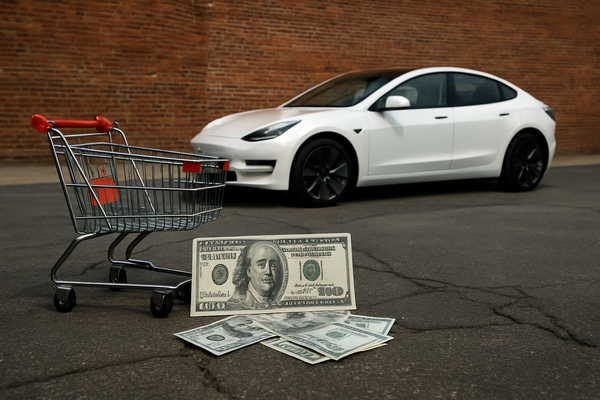
Electric vehicles just collided with economic gravity. Tesla rolled out lower-priced versions of its two best-selling models, yet the stock fell sharply on the day. That paradox captures the new EV reality. Pricing competition is intensifying at the very moment policy incentives fade and the consumer balance sheet shows strain. Investors should expect a reset across the space rather than a straight-line recovery.
The headline is simple enough. Tesla introduced a Model Y Standard starting at $39,990 and a Model 3 Standard at $36,990. The trims come with fewer features, such as no Autosteer and reduced acceleration, to hit lower price points. Markets did not cheer. Shares fell about 4% on the day, with headlines from Investor’s Business Daily and others noting the disappointment that the cuts were smaller than enthusiasts hoped and arrived after an initial social media tease. The S&P 500 and Nasdaq both pulled back that session, and consumer discretionary stocks underperformed.
Price tags are only half the story. The other half is policy. Goldman Sachs reiterated that the expiration of key U.S. IRA credits is a fourth quarter headwind for Tesla. Reuters and multiple outlets added context that last month’s loss of the $7,500 federal credit effectively raised real-world prices for many buyers. Kentucky’s governor underscored the macro-policy risk, saying the state “bet big on electric cars, only to see the administration kill a key incentive,” while warning that tariffs complicate reshoring plans. When policy turns from tailwind to crosswind, manufacturers face a demand curve that is less forgiving.
Consumer credit is flashing yellow too. VantageScore reported that auto loan delinquencies have climbed more than 50% over the last 15 years, framing autos as one of the riskiest products for credit scores. With monthly payments elevated and financing tighter, the elasticity investors expect from lower sticker prices may be capped in the near term. That goes beyond Tesla. One roundup noted that Tesla, Ford, General Motors, and Stellantis all had a bad Tuesday, breaking the S&P 500’s seven-day winning streak. Lucid shares fell even after record deliveries, with commentary pointing investors to a tougher fourth quarter without credits.
In other words, the EV category is fighting a two-front battle: price competition to win buyers and macro friction that reduces willingness or ability to transact. Tesla’s cuts are rational in that context, but they will pressure margins if cost reductions do not keep pace. The stock’s reaction to the reveal supports that view. After a run-up on hope, the news delivered reality, and reality means a lower floor for pricing across the segment.
Market behavior in adjacent names shows how jumpy sentiment has become. Joby Aviation and Archer Aviation popped and dropped around Tesla’s teasers, with some traders speculating on eVTOL tie-ins before the news turned out to be, simply, cars. That whipsaw speaks to a market segment that still trades on narrative at least as much as on fundamentals.
Another force complicating the EV equity story is a powerful capital rotation into artificial intelligence. AMD’s multiyear chip deal with OpenAI triggered a 24% surge in AMD shares and follow-on gains the next day as analysts called out tens of billions of dollars in potential revenue. Nvidia was largely unscathed, with several outlets noting investors “sticking with Nvidia” even after AMD landed the OpenAI partnership. At the same time, Oracle’s AI cloud margin report raised questions about profitability, knocking tech broadly for a session. The contrast is stark. Chips tied to AI data centers are attracting incremental risk capital, while EV makers are cutting prices to defend unit volumes.
Investors do not have to abandon the category, but the playbook needs to change. The immediate winners will be companies that can compress cost per kilowatt-hour faster than they compress price, defend gross margin dollars, and preserve balance sheet flexibility. Tesla’s board-level goals still envision 20 million units over the next decade, yet delivery beats will matter less than unit economics as policy support ebbs. Goldman maintains an equal weight view with a higher price target on better deliveries, while cautioning that lost credits are a near-term drag.
Legacy automakers will face hard choices. The broad sell-off across Ford, GM, and Stellantis after Tesla’s news suggests markets expect more price response. A hybrid mix shift will feel sensible in a soft consumer environment, but strategic indecision risks falling behind on full battery electric cost curves. For pure plays, the Lucid example is instructive. Record quarterly deliveries did not prevent a share price drop, which implies investors are discounting forward demand quality and funding needs more than rear-view unit counts.
Macro wildcards add to volatility. Gold briefly crossed $4,000 an ounce as investors hedged a drawn-out U.S. government shutdown and political noise in Europe. Tariff headlines cropped up across sectors, with importers warning of multi-million dollar cost hits. Those trends do not uniquely target EVs, but they compress the disposable income that would otherwise fund new car purchases, and they can lift input costs for batteries and components.
There are tactical opportunities. Supplier winners will be those with differentiated content tied to efficiency and safety that can avoid the worst of price passthroughs. Software features that can be monetized post-sale offer gross margin resilience. And within autos, the companies that can use price strategically without capitulating on profitability will take share. Tesla’s cheaper trims create a new reference point for the market. Others will be tempted to follow. Only those with structural cost advantages should.
The bottom line for investors is straightforward. The EV story is not broken, but the glide path is flatter. Policy support is less reliable than models assumed, consumer credit is tightening at the margin, and capital is chasing AI more aggressively than autos. Expect more price announcements, more margin variability, and more separation between manufacturers that can compete on cost and those that can only compete on price. In that reset lies the next set of long-duration winners.












